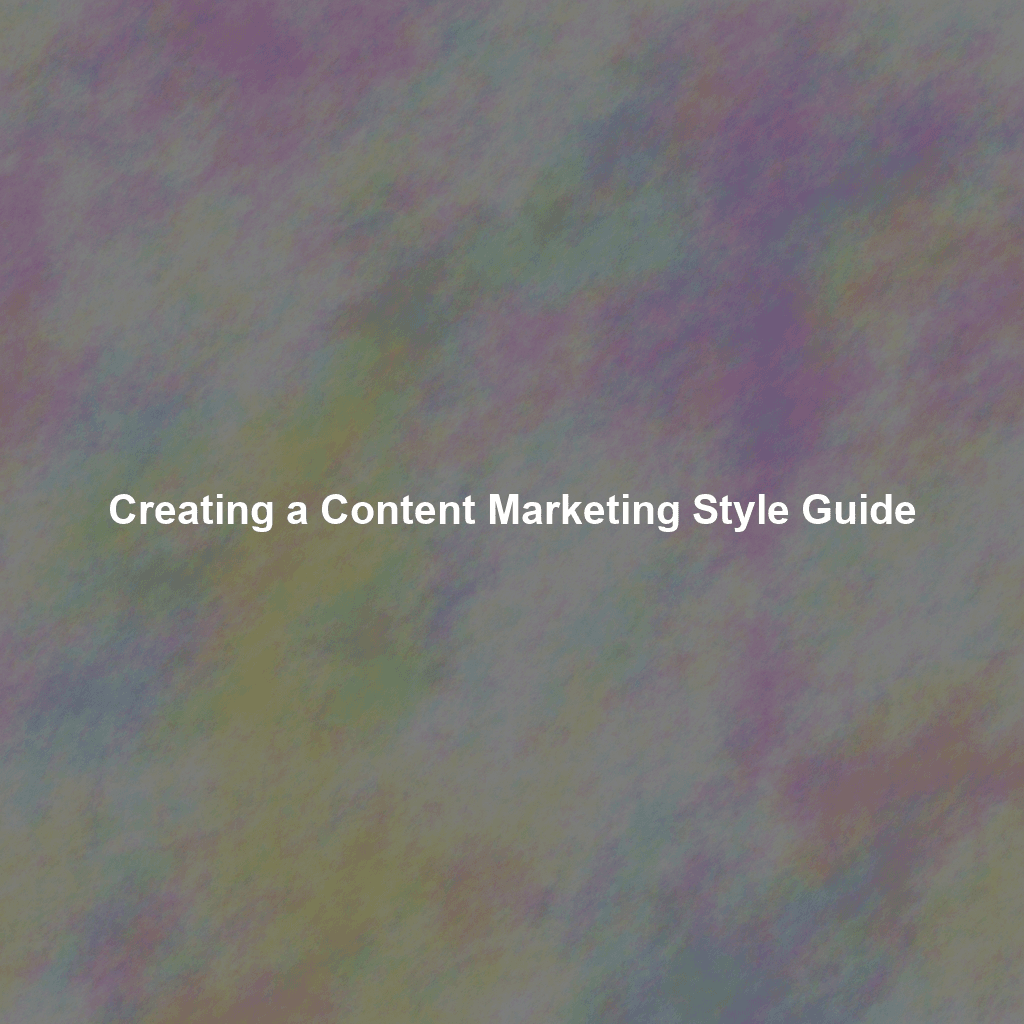Why You Absolutely Need a Content Marketing Style Guide
In the wild west of online content, consistency is king (or queen!). You might have a brilliant content marketing strategy, pumping out blog posts, social media updates, and email newsletters. But if each piece feels like it’s from a different company, you’re losing credibility and confusing your audience. That’s where a content marketing style guide steps in – your secret weapon for building a cohesive and impactful brand presence.
Think of your content marketing as a symphony. Each instrument (blog post, video script, social media copy) needs to play in harmony. A style guide acts as the conductor, ensuring every element works together to create a beautiful, recognizable melody that resonates with your target audience. Without it, you risk a cacophony of disjointed messaging that turns potential customers away.
What is a Content Marketing Style Guide?
A content marketing style guide is a documented set of rules and guidelines that dictate how your brand communicates in all its online content. It covers everything from grammar and tone to branding and visual elements, ensuring a consistent and professional voice across all your platforms. It’s more than just a grammar manual; it’s a blueprint for how your brand interacts with the world.
The Core Components of a Killer Content Marketing Style Guide
Building a robust style guide might seem daunting, but breaking it down into manageable sections makes the process far less intimidating. Here’s a breakdown of the key components:
1. Brand Voice and Tone
This is the heart and soul of your style guide. Defining your brand voice and tone helps your team create content that resonates with your audience on an emotional level. Consider these questions:
- What is your brand’s personality? Are you playful and humorous, or serious and professional?
- What values does your brand represent? Honesty, innovation, customer service?
- How do you want your audience to feel when they interact with your content? Informed, inspired, entertained?
- Who is your ideal customer? Develop detailed audience personas and tailor your voice to resonate with them.
Provide concrete examples of how your brand voice translates into different situations. For instance, instead of saying “Be professional,” you might say, “Use a formal tone in blog posts and white papers, avoiding slang and jargon unless specifically defined for the audience.” For social media, the tone may be more conversational and engaging. The more specific you are, the easier it will be for your team to implement the guidelines.
2. Grammar and Mechanics
While brand voice establishes how you say things, grammar and mechanics dictate the correctness of your writing. This section should cover:
- Preferred style guide: AP Style, Chicago Manual of Style, or a modified version of either. Be explicit about which style guide you’re adhering to.
- Punctuation rules: Address common punctuation errors like comma splices, misused apostrophes, and the Oxford comma (to use it or not to use it!).
- Grammatical preferences: Active vs. passive voice, sentence structure, and preferred verb tenses.
- Spelling: UK vs. US spelling. Ensure consistency throughout all content.
- Capitalization: Rules for headlines, subheadings, and specific terms.
Don’t just list rules; provide examples. For instance, instead of saying “Use active voice,” show a before-and-after example: “Passive: ‘The report was written by the team.’ Active: ‘The team wrote the report.'”
3. Formatting and Style
How your content looks is just as important as what it says. This section should outline rules for:
- Headings and subheadings: Specify font sizes, styles, and the hierarchy of headings (H1, H2, H3, etc.).
- Paragraph length: Shorter paragraphs are generally easier to read online.
- Bullet points and lists: Formatting and usage guidelines.
- Font choices: Specify the fonts used for headings, body text, and other elements.
- Image usage: Rules for image size, resolution, alt text, and placement. Do you use stock photos or original imagery?
- Video Style Guidelines on Video Length, Music, intro/outro and other visual elements.
- Color palette: The official brand colors and their usage.
Provide templates for different content formats (blog posts, social media updates, email newsletters) to ensure a consistent visual style.
4. SEO Guidelines
Your style guide should also incorporate your SEO strategy. Include guidelines on:
- Keyword usage: How to research and incorporate relevant keywords naturally into your content.
- Meta descriptions: How to write compelling meta descriptions for search engine results pages.
- Internal and external linking: Best practices for linking to other pages on your website and to reputable external sources.
- Image optimization: How to optimize images for search engines (alt text, file size, etc.).
- Header tag optimization: Best practices for the use of H1, H2, H3 and other header tags.
Emphasize the importance of creating high-quality, valuable content that satisfies user intent, rather than simply stuffing keywords into every sentence.
5. Brand-Specific Terminology
This section should define any industry-specific terms, acronyms, or unique words used by your company. It helps to clarify the proper usage of these terms and avoids confusion. Include:
- Product names: The correct spelling and capitalization of your products and services.
- Company-specific jargon: Define any unique terms used within your organization.
- Industry terms: Provide context for technical terms that your audience may not be familiar with.
This glossary ensures everyone on your team is speaking the same language and avoids inconsistencies in terminology.
6. Legal Considerations
Protect your brand and avoid legal issues by including guidelines on:
- Copyright and trademark usage: Rules for using your own trademarks and respecting the copyrights of others.
- Disclaimers and disclosures: When and how to include disclaimers and disclosures in your content (e.g., affiliate links, sponsored posts).
- Privacy policies: Links to your privacy policy and guidelines on handling user data.
- Fair Use: Explanation of the circumstances when use of copyrighted work is allowed.
Consult with your legal team to ensure this section complies with all applicable laws and regulations.
7. Content Workflow and Review Process
Outline the steps involved in creating and publishing content, from brainstorming to approval. This section should cover:
- Content creation process: The steps involved in creating a piece of content (e.g., research, writing, editing, design).
- Review and approval process: Who is responsible for reviewing and approving content before it is published.
- Editorial calendar: How the editorial calendar is managed and updated.
- Tools and resources: A list of the tools and resources available to content creators (e.g., grammar checkers, style guides, image libraries).
- Process for submitting feedback and revisions
A clear workflow ensures that content is created efficiently and to a consistent standard.
Tips for Creating an Effective Style Guide
Creating a style guide is an iterative process. Here are some tips to make the process smoother and more effective:
- Start small: Don’t try to create a comprehensive style guide overnight. Start with the most important elements and add more detail as needed.
- Involve your team: Get input from your content creators, marketers, and other stakeholders to ensure the style guide is practical and useful.
- Keep it concise: Avoid unnecessary jargon and keep the language clear and easy to understand.
- Use examples: Illustrate your guidelines with clear and concise examples.
- Make it accessible: Store the style guide in a central location where everyone can easily access it.
- Update it regularly: The style guide should be a living document that is updated as your brand evolves.
- Promote it: Make sure all employees are aware of the style guide and understand its importance.
Maintaining and Updating Your Style Guide
A style guide is not a “set it and forget it” document. It’s a living, breathing resource that needs to be updated regularly to reflect changes in your brand, the industry, and content marketing best practices. Schedule regular reviews to identify areas that need updating and ensure that the style guide remains relevant and useful.
Collect feedback from your team on how the style guide is working in practice. Are there any areas that are unclear or difficult to implement? Are there any topics that are missing? Use this feedback to improve the style guide and make it even more valuable.
The Long-Term Benefits of a Content Marketing Style Guide
Investing time and effort into creating and maintaining a content marketing style guide pays off in the long run. Here are some of the key benefits:
- Improved Brand Consistency: Ensures a consistent brand voice and tone across all your content, strengthening brand recognition and credibility.
- Enhanced Content Quality: Provides clear guidelines for grammar, style, and SEO, resulting in higher-quality content.
- Increased Efficiency: Saves time and effort by providing a single source of truth for content creation.
- Reduced Errors: Helps to prevent errors in grammar, spelling, and style.
- Better Collaboration: Facilitates collaboration among content creators and marketers.
- Stronger SEO Performance: Incorporates SEO best practices into your content creation process.
- Improved ROI: Ultimately, it can improve content marketing ROI by leading to higher-quality content, increased brand awareness, and more efficient content creation.
Conclusion
Creating a content marketing style guide is a crucial step in building a strong and consistent brand presence online. By defining your brand voice, establishing clear guidelines for grammar and style, and incorporating SEO best practices, you can ensure that your content is high-quality, engaging, and effective. So, take the time to develop a comprehensive style guide and empower your team to create content that truly represents your brand and resonates with your audience.
 Skip to content
Skip to content

